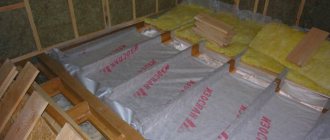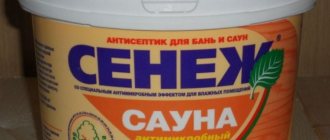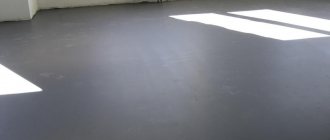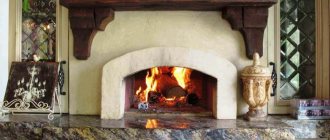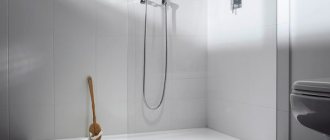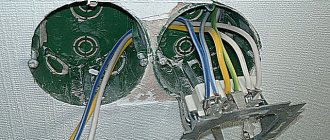Izospan groups
Good health to all readers!
I recently spoke with a manager who sells heating equipment to a German company. I found out that energy saving standards in the European Union are almost twice as strict as ours. Therefore, they spend approximately half as much energy (gas, electricity, etc.) to heat one conventional square meter. Insulation in accordance with the requirements is a mandatory norm.
Our modern buildings widely use mineral basalt insulation for roofs, walls, floors, etc. However, the insulation itself needs protection from moisture and steam coming from the external and internal environment. Without it, it loses its properties ahead of time and the heat loss of the building increases. And with them comes energy consumption.
Today we’ll talk about protecting insulation, as well as wooden structures from wind and wet condensation. To be specific, the topic is this: isospan: instructions for use. Let's consider all existing markings...
For information: Izospan is a non-woven material made on the basis of membrane polypropylene. Purpose – protection of thermal insulation materials and structures of houses, baths from the influence of the external environment.
Why Izospan? Because this is one of the few companies that produces the full range of protection for hydro vapor barrier. Here are the main groups of materials and their purpose:
Technical characteristics of reflective vapor barrier for baths (Izospan FB)
Separately, we should dwell on the technical characteristics of films made from Izospan FB. This material has a number of important properties, due to which it is often used to cover the walls of saunas and baths, as well as pipelines. The advantages of Izospan primarily include:
- Resistance to temperature fluctuations. Temperature range for use of the material is from -60 °C to +140 °C (according to the instructions).
- Reflective double-sided insulation VPE 10 mm.
- Reliable protection against mold, mildew and corrosion.
- Excellent wind protection, if you strictly follow the instructions for using Izospan.
- Noise insulation.
- Saving electrical energy for heating the room.
Conclusion
In the video presented in this article you will find additional information on this topic. Also, based on the text presented above, we can conclude that vapor barrier has certain differences from waterproofing and completely different materials must be used for its installation.
At the same time, the process of manufacturing such protection is quite simple and almost anyone can handle it, but you must be very careful when working, since all these insulators tolerate mechanical stress very poorly.
Did you like the article? Subscribe to our Yandex.Zen channel
Where to buy Izospan FB?
Izospan FB is a building material that is quite widespread and actively used for various types of installation. As a result, there are also many companies that can offer it to you. How to choose “yours”?
Do not rush to immediately respond to the offers of those who offer fabulously low prices for reflective insulation. It’s likely that the cost of the product will be the only thing you really save on. The quality will leave much to be desired.
The need to purchase Izospan is a case when it is much wiser to turn to market leaders, because who, if not them, knows what customers need? One of the famous suppliers is ours. What other benefits can we offer our customers?
- Affordable prices for the Izospan FB brand and other heat-insulating building materials that are presented in our online catalog, for example, Penofol.
- Wide range of products.
- Cooperation with manufacturers whose names are known not only in Russia, but throughout the world.
- Many years of experience and dozens of positive feedback on cooperation. Competent advice from specialists that will be useful not only to those who are buying building materials for their home or bathhouse for the first time, but also to professional builders who may also have difficulties, especially if this or that new product has appeared on the market.
- Consistently fast and timely delivery not only in Moscow and the Moscow region, but throughout Russia.
Concluding the conversation about Izospan FB, let us remind you once again: the most important thing is not the price of the material, but its quality. You can be happy when you buy bath foil for a minimal price, and then be sad when it turns out that the promises made by the manufacturer are not fulfilled. offers only high-quality reflective insulation options!
Technology: DIY
We will not talk again about how floor and false ceilings are made. You can read about it here.
When we already have a rough ceiling of one type or another, we can attach a layer of vapor barrier material to it.
Foil and foil-coated polymers are attached from below, from the side of the steam room. Moreover, it is worth remembering that there is also an overlap of 10-15 cm on the wall. The strips are overlapped, also 10-15 cm. It is advisable to seal the fastening with a stapler and the joints with metallized tape.
But the films can be placed from the attic side directly on the “floor”, and on them, without any intermediate material, you can put insulation - be it mineral wool, ecowool, expanded clay or something else.
Don’t forget that the top of the insulation is covered with vapor-PERMEABLE waterproofing.
In principle, the films could also be attached from below, like foil. Both options are acceptable . Actually, the entire vapor barrier of the ceiling in a bathhouse with your own hands comes down to either hemming it from below, from the ceiling side, or laying it from above, from the side of the attic or attic floor.
And all the subtleties are the careful sealing of the joints and the transition to the walls. That's all. The basic tools you will need are a stapler and scissors.
Reflective heat-steam-waterproofing material with energy-saving effect Izospan FB (35 m2)
Application:
Izospan FB must be sealed with adhesive aluminum tape Izospan FL termo!
- width - 1.2 m size - 35 m²
Specifications
material Izospan FB:
| Water resistance mm.water column, not less | UV stability, months | ||
| 350/340 | vapor-tight | waterproof | 3-4 |
Waterproofing for baths, saunas and steam rooms Izospan FB
A good steam room or sauna should have high-quality walls, floors and ceilings. High humidity and large temperature changes place high demands on structures and parts. Without special protection from the aggressive effects of moisture, steam and high temperature, the walls will quickly become unusable. Mold and mildew may spread. The performance properties of the steam room will gradually and constantly decrease. In this context, this applies to all bath options. Several years ago I released a special product Izospan fb for baths. Foil vapor barrier Izospan FB is designed specifically to retain and retain steam along with heat. The second most important function of Izospan fb foil is to preserve the integrity of the building and protect it from the negative effects of steam.
What is the difference between vapor barrier and waterproofing
Vapor barrier films
Now this is an interesting question. In essence, in both cases we are talking about the effect of moisture, it’s just that in the first case an increased temperature is added to it. Therefore, it would be correct to use these concepts and related materials something like this:
- vapor barrier is done from the inside of the room so that water vapor that arises inside does not turn into condensation when faced with the cold of the external environment;
- waterproofing is done primarily to protect against moisture coming from outside, and it can be in the form of water vapor or precipitation.
When it comes to ceiling insulation, vapor barrier is the bottom layer, waterproofing is the top layer. However, if the bathhouse has a second floor with a residential attic, then the term “waterproofing” becomes somewhat arbitrary, because protection is carried out from the same vapors, only found in the insulation.
Hence, probably, the constant confusion that can often be found in descriptions.
Everything is clear with the roof: the layer located directly under the roofing material is waterproofing, because precipitation can seep into it, and the layer that is made from the inside on top of the insulation is a vapor barrier . See the article When is it necessary to insulate the roof of a bathhouse and when is there no point? Roof thermal insulation technology
REMEMBER! There is also a purely mechanical difference between the materials used for vapor and waterproofing. The vapor barrier does not “breathe” at all; it is designed not to let anything pass through it at all - neither air, nor steam, nor liquid. And waterproofing is preferably “breathable”, that is, capable of releasing water vapor in one direction, and in the opposite direction, preventing its penetration.
If you take this into account, do not make any mistakes either when steam or waterproofing the ceiling in the bathhouse. Here’s another video that will reinforce what has been said (advertising, of course, but you don’t have to watch it to the end):
Izospan FB reflective hydro-vapor barrier for saunas and baths
Izospan FB is a vapor-waterproofing membrane with a base made of high-strength kraft paper, one side of which is covered with metallized lavsan. It works with an energy-saving effect, thanks to the combination of two qualities - vapor barrier and heat reflection. It is used in rooms with a high temperature of +140°C, for example, in baths, hammams, saunas, etc. Now Izospan for a bath will help reduce heat loss through the enclosing structures, as well as prevent them from getting wet from steam and high humidity from the steam room.
Traditional insulation methods and materials
Progress has both disadvantages and advantages. But when it comes to vapor barriers, traditional methods of making ceilings vapor-tight turn out to be very questionable when compared with what modern technology has given us.
Just for reference: in Russia, ceilings in log buildings were made on three beams attached to opposite walls of the log house. Poles were placed across these beams - these were logs or half-logs. They formed the basis of the then ceiling. Of course, gaps formed between the poles .
So, the only analogue of a vapor barrier in the construction of floors at that time could be covering these cracks with clay . Yes, but as insulation they put everything on top of them - straw, and even hay, and yarn, and hemp, and flax, and twigs, and dry leaves... In general, they put what was at hand.
For reference, we studied part of an archaeological book about construction in Rus' in the 10th-11th centuries. Now think for yourself - why bother so much when even with the smallest budget you can buy plastic film and protect the attic space from steam with it?
Izospan FB: application
- Bathhouse - steam room, adjacent rooms
- saunas
- hammams
- rooms heated to a temperature of +140°C
- buildings where constant high temperature maintenance is required without wasteful energy costs
The insulating material is placed on the inside of the thermal insulation, under the finishing material, and the metal side faces the room. To start the process of heat reflection, you need to leave 40-50 mm between the finishing layer and the reflective side of the membrane. It should be especially emphasized that the joints must be sealed with aluminum adhesive tape.
Advantages of Izospan FB
- operates at temperatures up to +140°C;
- reflects up to 90% of heat;
- significantly reduces heating costs;
- has high strength;
- keeps steam in the steam room for a longer time;
- significantly reduces the time for heating the bath to the required temperature;
- UV resistant;
- positive reviews from those who have used Izospan FB;
- environmental cleanliness;
- long service life.
For more detailed information, see the table - Izospan FB technical specifications
Izospan FB: price matches quality
On sale is a special membrane for baths and saunas - Izospan FB. You can buy it at a really inexpensive price, especially since our construction base is a dealer of the manufacturer. Due to its narrow scope of application, many do not know about this material, but it is much cheaper than insulation and in practice can significantly extend its service life.
Operating principle
The work of the vapor barrier material is as simple as the pendulum of grandma's walker. A water molecule, an air molecule and a steam molecule have different sizes. In an array of absolutely impenetrable material, calibrated perforation is performed, that is, holes of a certain size are made that freely allow an air molecule to pass through, but block the penetration of a steam or water molecule. That is, ideally, high-quality material guarantees the notorious “breathing effect”, when air circulates freely and moisture is cut off.
Attention! The pore size of the material determines the specificity of blocking water or steam molecules, hence the specialization of insulating materials. This is either a vapor barrier or waterproofing. Each one works in its own way and the effect of the work is different.
Types of insulation materials
As mentioned above, a high-quality insulated steam room is economical, practical and, most importantly, durable. The modern construction industry offers three main types of thermal insulation materials:
- Styrofoam. Convenient, lightweight, effective. But it's not suitable for the bathhouse. When heated, there is a high probability of releasing highly toxic volatile compounds, which will not ozonize the air in the steam room;
- Glass wool. Affordable, easy to install, quite effective;
- Mineral wool also has good properties, quite applicable in a steamy room.
However, both cotton wools, despite all their positive properties, are very hygroscopic, readily absorb condensation and are extremely poorly ventilated and, as a result, take a long time to dry. Contact with wet cotton insulation of any building material is very unpleasant for the latter, and sometimes fatal.
In general, insulation is needed, and its insulation is even more necessary.
Vapor barrier and its diversity
The market is saturated with various vapor barrier materials, each of which has, albeit insignificant, feature or specificity:
- Single-layer vapor barrier materials such as high molecular weight polyethylene film. One of the most affordable and fastest solutions. Available in two-layer sleeves of sufficient width, which ensures quick and easy installation. Due to the specific structure of polyethylene fabric, it reliably blocks water, steam and air. Builders call such films with the slang expression “grouse”;
- Anti-condensation multilayer vapor barrier. It has several layers of material with a set of strictly calibrated pore holes in each working layer. It works selectively and delicately, ensures sufficient gas exchange and air convection, but requires precise installation on the “front” and “back” sides, otherwise it will not work correctly;
- Combined heat-steam-waterproofing based on metallized aluminum foil. Provides not only protection from water and steam, but also exhibits a significant heat-accumulating effect. A complex, but quite expensive remedy;
- Glassine, rolled roofing felt and other materials based on modified bitumen. They are good, but not for a bath, because at high temperatures they tend to scorch and release volatile substances with a pungent and unpleasant odor, which, like polystyrene foam, also do not ozone the air;
- Insulation based on liquid synthetic rubber and caoutchouc. They have excellent insulating properties and are extremely convenient to apply to any surface, including curved and radius ones. However, roads and in premises such as baths must be used very carefully, primarily due to their synthetic origin.
Attention! Coating vapor barrier of the “liquid rubber” type, based on synthetic rubber, is well suited for floor vapor barrier, forming a plastic polymer film resistant to mechanical stress.
Attention to joints: installation and installation features
The principle of operation of a system such as bathhouse vapor barrier is to carefully adjust and seal seams and joints. Violations of the integrity of the vapor barrier mass are a direct path to the formation of local breakdowns in the protection, which will then become the focus of future problems.
Main events:
- Purchase of material with an insurance premium of about 10-12% of the covered area of the bathhouse.
- Preparation of wall and ceiling surfaces to avoid damage primarily to film materials. Particular attention to the elimination of sharp, protruding elements, chips and other things.
- Careful and accurate cutting of material.
- Thorough joining of seams or overlap of insulation sheets at their junction.
- Sealing seams using tape, preferably double-sided metallized or adhesive.
- Application of a double-sided insulation protection system. On the outer wall side from condensation, on the inner wall from direct exposure to steam.
- Leaving an air gap between the insulation, vapor barrier and wooden cladding of the steam room for free air convection in the internal space. As a general rule, an air gap of 25-40mm will normally provide satisfactory convection.
Important! The vapor barrier for a sauna must meet the same principles and requirements, despite the significantly lower absolute humidity in a thermal room of this type.
Application area
Izospan FB is used as a high-strength and reliable vapor barrier in structures and buildings such as saunas, baths, and many other rooms characterized by a fairly high temperature level. It is also installed in those rooms where the temperature of the so-called dry steam can reach a level of +140°C. In this space, such a two-layer membrane perfectly maintains the most comfortable temperature level.
! The canvases are specially laid so that there is a gap of 4-5 cm between the interior finishing and the metallized surface of the membrane itself. Such a gap is very necessary to ensure all conditions for thermal reflection.
The material is installed from bottom to top in separate sheets. In this case, the overlap at vertical and horizontal joints is from 150 mm to 200 mm. All elements of the layer are attached using wooden slats.
Due to its reflectivity, which now reaches more than 90%, the membrane helps reduce heat transfer through the walls and roofs of the bathhouse. This means that with proper installation, you can retain steam in the bathhouse, and also prevent the appearance of dampness, which inevitably occurs inside the ceilings and walls of the bathhouse. Such dampness is the result of periodic changes in both the level of humidity and the temperature inside the structure itself. This is why the use of Izospan FB products is so justified.
Basic installation rules
To carry out all installation work, you do not need to have any special experience or have a set of professional tools on hand. You can start and finish the work yourself, following a few tips.
The vapor barrier is always installed under the internal cladding. These can be panels, drywall or lining. In this case, the membrane is joined to the insulation so that its reflective surface “looks” into the room.
It is necessary to leave a gap of several centimeters between the metallized surface of our material and the interior decoration of the lining or panels. The purpose of the gap is to reflect heat as much as possible. Lay the panels horizontally. If you are processing walls, then you need to do this from the bottom up, so that each individual part overlaps the second by 15-20 cm, both vertically and horizontally. Next, using special wooden slats, on which you will later mount the finishing, secure all the panels.
A special connecting tape that can withstand temperatures of 140°C will help you provide additional sealing of the seams. So, you can always save money on heating.
As you can see, the installation itself will not take much time or effort. And you will feel the benefits of using such a layer when using the room for its intended purpose. Separately, we note that the price for Izospan FB always remains within reason. Browse our offers and order the best double-layer membrane for your sauna.

